

Javierrelatre
Pictures: 26.XII.1998
| Nederlands |  |
||||
 |
Mills in Altoaragón - harinero, central eléctrica
Javierrelatre |
||||
| From Sabiñánigo take the road
to Huesca. In Hostal de Ipiés turn right and
follow the road to Caldearenas and Javierrelatre.
Leave the car where Central eléctrica is signposted.
It's about one km to the powerstation and another two for the
mill. The mill is in fact closer to Caldearenas, but I prefer the longer
walk which is very enjoyable. The mill takes its water from the Río
Gállego.
Pictures: 26.XII.1998 |
|||||
| The mill is very ruinoso.
Although Pallaruelo
says it has been a batán also, I could only
find evidence for a powerstation (central eléctrica) and a flour mill (harinero).
The front would look over the river, were it not for the poplars taking over the site. They invaded the outlet of the cárcavo which is close to completely clogged. |
The roof is gone, as is most of the upper floor. Working our way through the scrap we recognised some old machinery in the harinero. The powerstation is easier to enter. The wheel shows how the generator was controlled from the upper floor. The Why will become clear further on. A wall on the ground floor carries a year mark: año 1922. |
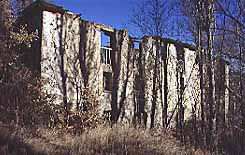 |
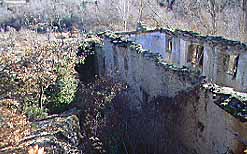 |
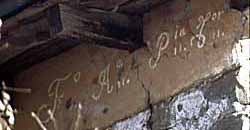 |
 |
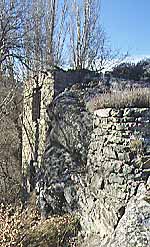 |
||
| Inscription on the side wall just under the roof (upper left on picture above) |
| The most interesting part is on the back side of the construction. If you round the mill you will find the path (below) and eventually reach the door visible behind the wheel at the same level as the upper window on the picture on the right (above). The same picture shows how the mill is build against a house-high rock. | The canal - broad and deep - taps the river near Caldearenas. It dives under the path and drains into a twin cubo. There is no other reservoir; the Río Gállego could probably be trusted. The cubos could be isolated from each other by a simple valve in a slit on the path. Their section is more or less oval and adapted to the shape of the rock. Look again at the door (above). Its base indicates the top of the cubo: a impressive waterbody and a lot of pressure. Definitely worth a visit! |
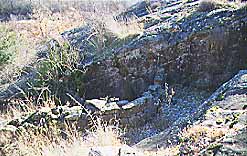 |
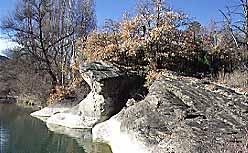 |
| While you are there, try to explore also the surface of the rock. The lichens are very nice. But there is more. Look for the religiously inspired engravings. I show a part of it on top of this page. It is the Virgen del Pilar, patroness of Aragón. |
|
Introduction Learn about the parts of a mill Visit the mills; catalogue Read more about mills; links © and e-mail: |
||